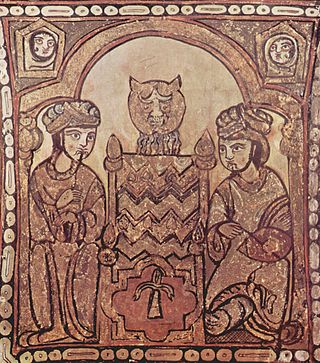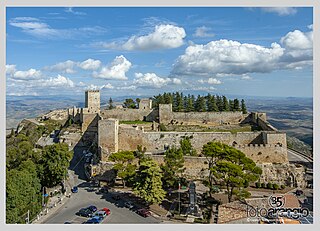Related Research Articles

Abū Jaʿfar Hārūn ibn Muḥammad al-Wathiq bi'Llah, commonly known by his regnal name al-Wathiq bi'Llah, was an Abbasid caliph who reigned from 842 until his death in 847.

The Battle of Lalakaon, or Battle of Poson or Porson, was fought in 863 between the Byzantine Empire and an invading Arab army in Paphlagonia. The Byzantine army was led by Petronas, the uncle of Emperor Michael III, although Arab sources also mention the presence of the Emperor in person. The Arabs were led by the emir of Melitene (Malatya), Umar al-Aqta.

Theoktistos or Theoctistus was a leading Byzantine official during the second quarter of the 9th century and the de facto head of the regency for the underage emperor Michael III from 842 until his dismissal and murder in 855. A eunuch courtier, he assisted in the ascent of Michael II to the throne in 820, and was rewarded with the titles of patrikios and later magistros. He held the high posts of chartoularios tou kanikleiou and logothetēs tou dromou under Michael and his son Theophilos. After Theophilos' death in 842, Theoktistos became a member of the regency council, but soon managed to sideline the other members and establish himself as the virtual ruler of the Empire. Noted for his administrative and political competence, Theoktistos played a major role in ending the Byzantine Iconoclasm, and fostered the ongoing renaissance in education within the Empire. He also continued the persecution of the Paulician sect, but had mixed success in the wars against the Arabs. When Michael III came of age in 855, his uncle Bardas persuaded him to throw off the tutelage of Theoktistos and his mother, the Empress-dowager Theodora, and on 20 November 855, Theoktistos was assassinated by Bardas and his followers.

Thomas the Slav was a 9th-century Byzantine military commander, most notable for leading a wide-scale revolt in 821–23 against Emperor Michael II the Amorian.

The history of Islam in Sicily and southern Italy began with Arab colonization in Sicily, at Mazara, which was captured in 827. The subsequent rule of Sicily and Malta started in the 10th century. The Emirate of Sicily lasted from 831 until 1061, and controlled the whole island by 902. Though Sicily was the primary Muslim stronghold in Italy, some temporary footholds, the most substantial of which was the port city of Bari, were established on the mainland peninsula, especially in mainland southern Italy, though Arab raids, mainly those of Muhammad I ibn al-Aghlab, reached as far north as Naples, Rome and the northern region of Piedmont. The Arab raids were part of a larger struggle for power in Italy and Europe, with Christian Byzantine, Frankish, Norman and indigenous Italian forces also competing for control. Arabs were sometimes allied with various Christian factions against other factions.

The Muslim conquest of Sicily began in June 827 and lasted until 902, when the last major Byzantine stronghold on the island, Taormina, fell. Isolated fortresses remained in Byzantine hands until 965, but the island was henceforth under Muslim rule until conquered in turn by the Normans in the 11th century.
Karbeas, also Karbaias (Καρβαίας), was a Paulician leader, who, following the anti-Paulician pogroms in 843, abandoned his service in the Byzantine army and went over to the Arabs. With the aid of the emir of Melitene, Umar al-Aqta, he founded the Paulician principality of Tephrike, which he ruled until his death in 863. During this period he participated alongside Umar in several raids against the Byzantine Empire.
Nasar, originally baptized Basil, was a distinguished Byzantine military leader in the Byzantine–Arab conflicts of the latter half of the 9th century.

The sack of Amorium by the Abbasid Caliphate in mid-August 838 was one of the major events in the long history of the Arab–Byzantine Wars. The Abbasid campaign was led personally by the Caliph al-Mu'tasim, in retaliation to a virtually unopposed expedition launched by the Byzantine emperor Theophilos into the Caliphate's borderlands the previous year. Mu'tasim targeted Amorium, an Eastern Roman city in western Asia Minor, because it was the birthplace of the ruling Byzantine dynasty and, at the time, one of Byzantium's largest and most important cities. The caliph gathered an exceptionally large army, which he divided in two parts, which invaded from the northeast and the south. The northeastern army defeated the Byzantine forces under Theophilos at Anzen, allowing the Abbasids to penetrate deep into Byzantine Asia Minor and converge upon Ancyra, which they found abandoned. After sacking the city, they turned south to Amorium, where they arrived on 1 August. Faced with intrigues at Constantinople and the rebellion of the large Khurramite contingent of his army, Theophilos was unable to aid the city.
Manuel the Armenian, was a prominent Byzantine general of Armenian origin, active from c. 810 until his death. After reaching the highest military ranks, a palace conspiracy forced him to seek refuge in the Abbasid court in 829. He returned to Byzantine service the next year, receiving the position of Domestic of the Schools from Emperor Theophilos, who had married his niece Theodora. Manuel remained in the post throughout Theophilos's reign, and reportedly saved the emperor's life in the Battle of Anzen in 838. According to one report, he died on 27 July 838 of wounds received during the battle, but other sources record his survival past this date, ascribing him a major role in the regency that governed the empire after Theophilos's death, and report that he died some time around 860.

The Sack of Damietta was a successful raid on the port city of Damietta on the Nile Delta by the Byzantine navy on 22–24 May 853. The city, whose garrison was absent at the time, was sacked and plundered, yielding not only many captives but also large quantities of weapons and supplies intended for the Emirate of Crete. The Byzantine attack, which was repeated in the subsequent years, shocked the Abbasid authorities, and urgent measures were taken to refortify the coasts and strengthen the local fleet, beginning a revival of the Egyptian navy that culminated in the Tulunid and Fatimid periods.

The siege of Syracuse from 877 to 878 led to the fall of the city of Syracuse, the Byzantine capital of Sicily, to the Aghlabids. The siege lasted from August 877 to 21 May 878 when the city, effectively left without assistance by the central Byzantine government, was taken by the Aghlabid forces.

The Battle of Marash was fought in 953 near Marash between the forces of the Byzantine Empire under the Domestic of the Schools Bardas Phokas the Elder, and of the Hamdanid Emir of Aleppo, Sayf al-Dawla, the Byzantines' most intrepid enemy during the mid-10th century. Despite being outnumbered, the Arabs defeated the Byzantines who broke and fled. Bardas Phokas himself barely escaped through the intervention of his attendants, and suffered a serious wound on his face, while his youngest son and governor of Seleucia, Constantine Phokas, was captured and held a prisoner in Aleppo until his death of an illness some time later. This debacle, coupled with defeats in 954 and again in 955, led to Bardas Phokas' dismissal as Domestic of the Schools, and his replacement by his eldest son, Nikephoros Phokas.

Constantine Phokas was a Byzantine aristocrat and general.
The Battle of Caltavuturo was fought in 881 or 882 between the Byzantine Empire and the Aghlabid emirate of Ifriqiya, during the Muslim conquest of Sicily. It was a major Byzantine victory, although it could not reverse the Muslim conquest of Sicily.

The siege of Salerno was one of the campaigns of the Aghlabids in southern Italy during their conquest of Sicily. The Lombard city of Salerno had strong defences and, despite the use of stone-throwing artillery, the siege lasted a little over a year from its beginning in late 871 or early 872. Prince Guaifer of Salerno led the defence, but the siege was only lifted by the arrival of an army of Lombards and Franks under the Emperor Louis II.

The siege of Taormina in 902 ended the conquest of the Byzantine city of Taormina, in northeastern Sicily, by the Aghlabids. The campaign was led by the deposed Aghlabid emir, Ibrahim II, as a form of armed pilgrimage and holy war. Ibrahim's forces defeated the Byzantine garrison in a hard-fought battle in front of the city walls, and laid siege to the city. Left unsupported by the Byzantine government, Taormina capitulated on 1 August. The population was massacred or sold into slavery. The fall of this last major Byzantine stronghold signalled the completion of the Muslim conquest of Sicily, which had been ongoing since the 820s, although some minor Byzantine outposts survived until the 960s.

The siege of Messina was launched by the Aghlabids, allied with the Neapolitans, against the Byzantine city of Messina from 842 to 843. The Allied forces managed to capture the city after a long siege.

The siege of Enna or Castrogiovanni was launched by the Aghlabids against the important Byzantine city of Enna in 859. The Aghlabid forces managed to capture the city.
The Battle of Butera happened in late 845 or early 846 between the Aghlabid army and the Byzantine army at Butera, south of Sicily. The Aghlabids achieved a resounding success against the Byzantines.